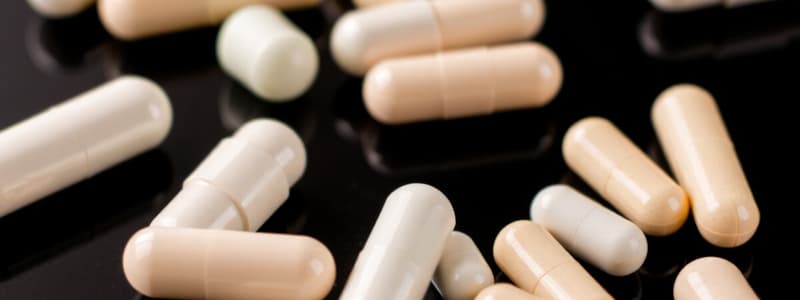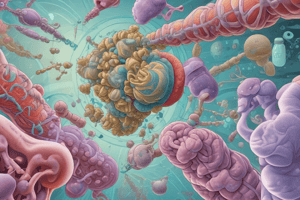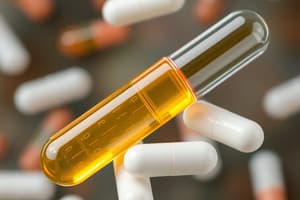Podcast
Questions and Answers
Which characteristic distinguishes bactericidal drugs from bacteriostatic drugs?
Which characteristic distinguishes bactericidal drugs from bacteriostatic drugs?
- Bactericidal drugs inhibit the growth of bacteria, while bacteriostatic drugs kill bacteria.
- Bactericidal drugs act in a synergistic fashion, while bacteriostatic drugs act in an additive fashion. (correct)
- Bactericidal drugs are safe in all animal species at recommended doses, while bacteriostatic drugs have narrow safety margins.
- Bactericidal drugs are effective against a wider range of bacteria than bacteriostatic drugs.
A veterinarian is treating a dog with a bacterial infection. Culture and sensitivity testing reveals the bacteria is susceptible to both tetracycline and penicillin. Considering the potential for resistance development, which drug is the MOST appropriate?
A veterinarian is treating a dog with a bacterial infection. Culture and sensitivity testing reveals the bacteria is susceptible to both tetracycline and penicillin. Considering the potential for resistance development, which drug is the MOST appropriate?
- Penicillin, because it is effective against a broad spectrum of bacteria.
- Tetracycline, because it is effective against both gram-positive and gram-negative bacteria.
- Penicillin, because it is a narrow-spectrum antibiotic, reducing the risk of resistance development. (correct)
- Tetracycline, because it is a bactericidal drug and will eliminate the bacteria more rapidly.
Which of the following correctly describes the mechanism of action of penicillin?
Which of the following correctly describes the mechanism of action of penicillin?
- Disruption of the cell membrane function.
- Inhibition of protein synthesis by binding to the 30S ribosomal subunit.
- Inhibition of cell wall synthesis by interfering with transpeptidase. (correct)
- Inhibition of DNA synthesis by blocking DNA gyrase.
Why are gram-negative bacteria generally more difficult to kill with antibiotics compared to gram-positive bacteria?
Why are gram-negative bacteria generally more difficult to kill with antibiotics compared to gram-positive bacteria?
Povidone iodine is classified as a(n):
Povidone iodine is classified as a(n):
Which of the following antibiotics is MOST likely to cause nephrotoxicity?
Which of the following antibiotics is MOST likely to cause nephrotoxicity?
A veterinarian is treating a cat for a suspected Mycoplasma infection. Which antibiotic should the veterinarian avoid?
A veterinarian is treating a cat for a suspected Mycoplasma infection. Which antibiotic should the veterinarian avoid?
A dog is being treated with a sulfonamide antibiotic. The owner reports that the dog is producing less urine and seems uncomfortable. What is the MOST likely cause?
A dog is being treated with a sulfonamide antibiotic. The owner reports that the dog is producing less urine and seems uncomfortable. What is the MOST likely cause?
Which statement about tetracyclines is MOST accurate?
Which statement about tetracyclines is MOST accurate?
Chloramphenicol is generally avoided for use in food animals because it:
Chloramphenicol is generally avoided for use in food animals because it:
Which statement is MOST accurate regarding the use of aminoglycosides?
Which statement is MOST accurate regarding the use of aminoglycosides?
A client reports that after administering erythromycin to their horse, the horse developed diarrhea. What is the MOST likely reason?
A client reports that after administering erythromycin to their horse, the horse developed diarrhea. What is the MOST likely reason?
Which statement regarding the mechanism of action of macrolides is MOST accurate?
Which statement regarding the mechanism of action of macrolides is MOST accurate?
Which of the following is TRUE regarding lincosamides?
Which of the following is TRUE regarding lincosamides?
Polymyxins are known for their ability to:
Polymyxins are known for their ability to:
What cellular process do quinolones affect, leading to their antibacterial effect?
What cellular process do quinolones affect, leading to their antibacterial effect?
What is the primary reason for avoiding excessive use of quinolones in immature animals?
What is the primary reason for avoiding excessive use of quinolones in immature animals?
What is the mechanism of action of sulfonamides?
What is the mechanism of action of sulfonamides?
When administering nitrofurantoin, what consideration should be taken into account regarding its absorption in monogastric animals?
When administering nitrofurantoin, what consideration should be taken into account regarding its absorption in monogastric animals?
What is the primary mechanism by which aminoglycosides exert their antibacterial effects?
What is the primary mechanism by which aminoglycosides exert their antibacterial effects?
Which is a potential side effect in pigs when using tylosin?
Which is a potential side effect in pigs when using tylosin?
What is the main target of action for antiviral drugs that are classified as early site drugs?
What is the main target of action for antiviral drugs that are classified as early site drugs?
Which is the mechanism of action of idoxuridine?
Which is the mechanism of action of idoxuridine?
Acyclovir is effective against what type of virus?
Acyclovir is effective against what type of virus?
What is the primary mechanism by which polyene macrolide antibiotics, such as amphotericin B and nystatin, exert their antifungal effects?
What is the primary mechanism by which polyene macrolide antibiotics, such as amphotericin B and nystatin, exert their antifungal effects?
What is the MOST important consideration when administering griseofulvin?
What is the MOST important consideration when administering griseofulvin?
Why should amprolium not be mixed with increased choline content?
Why should amprolium not be mixed with increased choline content?
True for a cell-cycle non-specific antineoplastic drug?
True for a cell-cycle non-specific antineoplastic drug?
Flashcards
Antimicrobials
Antimicrobials
Drugs acting on microbes such as bacteria, viruses, protozoa and fungi.
Antibacterial
Antibacterial
Drugs acting specifically on bacterial organisms.
Antibiotics
Antibiotics
Drugs produced from yeast or fungi with antimicrobial or antibacterial action.
Narrow spectrum
Narrow spectrum
Signup and view all the flashcards
Broad spectrum
Broad spectrum
Signup and view all the flashcards
Bacteriostatic
Bacteriostatic
Signup and view all the flashcards
Bactericidal
Bactericidal
Signup and view all the flashcards
Inhibition of cell wall synthesis
Inhibition of cell wall synthesis
Signup and view all the flashcards
Penicillin (G+)
Penicillin (G+)
Signup and view all the flashcards
Antistaphylococcal penicillin
Antistaphylococcal penicillin
Signup and view all the flashcards
Ampicillin
Ampicillin
Signup and view all the flashcards
Clavulanate + amoxicillin
Clavulanate + amoxicillin
Signup and view all the flashcards
Cephalosporins
Cephalosporins
Signup and view all the flashcards
Tetracycline
Tetracycline
Signup and view all the flashcards
Aminoglycosides
Aminoglycosides
Signup and view all the flashcards
Chloramphenicol
Chloramphenicol
Signup and view all the flashcards
Macrolides
Macrolides
Signup and view all the flashcards
Lincosamides
Lincosamides
Signup and view all the flashcards
Polymyxin & Colistin
Polymyxin & Colistin
Signup and view all the flashcards
Sulfonamides
Sulfonamides
Signup and view all the flashcards
Quinolones
Quinolones
Signup and view all the flashcards
Nitrofurans
Nitrofurans
Signup and view all the flashcards
Transcription Analog Drug/ Pyrimidine Nucleoside
Transcription Analog Drug/ Pyrimidine Nucleoside
Signup and view all the flashcards
Maturation Drugs
Maturation Drugs
Signup and view all the flashcards
Host Resistance
Host Resistance
Signup and view all the flashcards
Host Modulators
Host Modulators
Signup and view all the flashcards
POLYENE MACROLIDE ANTIBIOTICS
POLYENE MACROLIDE ANTIBIOTICS
Signup and view all the flashcards
drugs IMIDAZOLE
drugs IMIDAZOLE
Signup and view all the flashcards
AMPROLIUM
AMPROLIUM
Signup and view all the flashcards
Study Notes
- These are finals notes from a Pharmacology lecture
Module 7 - Antibiotics
- Antimicrobials kill or inhibit microbes, including bacteria, viruses, protozoa, and fungi, can't be seen by the naked eye
- Doxycycline and tetracycline treat ehrlichia (protozoa) and E. coli
- Antibacterials are drugs that act specifically on bacteria
- Penicillin treats streptococcus, staphylococcus, E. coli, and salmonella
- Antibiotics are drugs produced from yeast or fungi with antimicrobial or antibacterial action
- Povidone iodine is a mineral used to disinfect wounds and kill bacteria
- Penicillin and sulfonamides are examples of antibiotics
- Parasiticides kill parasites, including ectoparasiticides (for external parasites) and anthelmintics (for worms)
- Antifungal drugs treat fungal infections
- Anti-cancer drugs treat tumors and cancer
Antibiotics Classified by Spectrum of Activity
- Narrow-spectrum antibiotics target a specific bacterium (either gram-positive or gram-negative)
- Broad-spectrum antibiotics act on all bacteria
Stains and Fixers in Gram Staining
- Crystal violet is the primary stain
- Iodine acts as a fixer
- Alcohol removes excess stain
- Safranin is the secondary stain
- Red or pink stained bacteria are Gram-negative
Why Gram-Negative Bacteria are Harder to Kill
- Gram-negative bacteria have a thinner cell wall compared to Gram-positive bacteria
Antibiotics Classified by Type of Action
- Bacteriostatic antibiotics inhibit bacterial growth in an additive fashion
- Examples of bacteriostatic drugs include tetracyclines, chloramphenicol, macrolides, lincosamides, spectinomycin, sulfonamides, griseofulvin, rifampin, and trimethoprim
- Bactericidal antibiotics kill bacteria in a synergistic fashion
- Examples of bactericidal drugs include penicillin, cephalosporins, aminoglycosides, TMP-S (trimethoprim and sulfonamides), nitrofurans, metronidazole, quinolones, amphotericin, bacitracin, and novobiocin
Antibiotics Classified by Mode of Action
- Some antibiotics inhibit cell wall synthesis
- Examples include penicillin, cephalosporins, vancomycin, bacitracin, and cycloserin
- Some antibiotics impair cell membrane function with cell membrane but can’t protect cell
- Examples include polymyxin, colistin, tyrocidine, amphotericin, and nystatin
- Some antibiotics inhibit protein synthesis
- Examples include tetracycline, aminoglycoside, chloramphenicol, macrolides, and lincosamides
- Some antibiotics inhibit DNA synthesis
- Examples include novobiocin and quinolones
- Some antibiotics inhibit DNA-dependent RNA polymerase
- Rifamycin (brand Rifampin)
- Some antibiotics inhibit folic acid synthesis
- Examples include sulfonamides and trimethoprim
Antibiotics and Their Sources
- Penicillin comes from Penicillium notatum and Penicillium chrysogenum
- Chlortetracycline comes from Streptomyces aureofaciens
- Oxytetracycline comes from Streptomyces rimosus
- Streptomycin comes from Streptomyces griseus
- Erythromycin comes from Streptomyces erythreus
- Bacitracin comes from Bacillus subtilis
- Tylosin comes from Streptomyces fradiae
- Vancomycin comes from Streptomyces orientalis
- Gentamycin comes from Mircomonospora purpurea
- Nevoblocine comes from Streptomyces niveus
Penicillin Types and Properties
- Narrow-spectrum B-lactamase sensitive (G+)/ natural penicillin
- Pen G (benzylpenicillin), Pen V and Pheneticillin
- Narrow-spectrum B-lactamase resistant (G+)/ antistaphylococcal penicillin
- Oxacillin, Cloxacillin, Dicloxacillin, Flucloxacillin, Methicillin, and Temocillin
- Broad-spectrum B-lactamase sensitive/aminopenicillin
- Ampicillin, Amoxicillin, Hetacillin, Pivampicillin, Talampicillin, and Mecillinam
- Broad-spectrum B-lactamase sensitive with extended spectra (can handle Pseudomonas)
- Carbenicillin, Azlocillin, Mezlocillin, and Piperacillin
- B-lactamase protected broad spectrum (potential pen.)
- Clavulanate + potentiated amoxicillin (Clavamox- kilala as co amoxiclav), sulbactam+ potential ampicillin, ticarcillin+ clavulanic acid and piperacillin+tazobactam
- MOA of penicillin: Inhibit cell wall synthesis (affects growing cells/ combination with bacteriostat is inappropriate)
- Interferes with transpeptidase (enzyme responsible for crosslink between peptidoglycan strands)
- Penicillin binds (PBP) on the cell wall of susceptible bacteria and inhibits transpeptidation
- Prevents peptidoglycan synthesis, leading to cell wall-deficient forms (spheroplasts and filamentous forms) and autolysis, resulting in cell death (bactericidal action)
Penicillin Side Effects and Interactions
- Penicillin can biotransform into penicilloic acid, which tends to be allergenic and can lead to cross-sensitivity
- Guinea pigs, chinchillas, birds, and snakes & turtles are sensitive
- Penicillin interacts with salicylates, phenylbutazone, sulfonamides, and anticoagulants
- Penicillin + cephalosporin leads to pseudomonas
- Penicillin + streptomycin/gentamycin leads to Listeria
- Withdrawal times for penicillin: 7-30 days in meat and 2-3 days in milk
Cephalosporins and Their Properties
- 1st generation cephalosporins are narrow spectrum for G+, B-lactamase sensitive, and not effective for anaerobic bacteria
- Cephalothin, Cephaloridine, Cephairin
- Cefazolin, Cephalexin (most popular), Cephradine and Cefadroxil
- 2nd generation cephalosporins are broad-spectrum (G+G-), B-lactamase resistant, and not effective for obligate anaerobic bacteria
- Cefamandole, Cefoxitin, Cefotiam, Cefaclor (most popular), Cefuroxime (most popular) and Ceforamide
- 3rd generation cephalosporins are narrow spectrum (G-), B-lactamase resistant, and pass the blood-brain barrier
- Drugs: Ceftiofur, Ceftriaxone, Cefsulodin, Cefotaxime, Cefoperazone, and Moxalactam
- 4th generation are broad-spectrum (G+G-), B-lactamase resistant, and have extended spectra
- Cefepime
- Cephalosporins MOA: same as penicillin
Cephalosporins: Indications and Side Effects
- Used to treat Cephairin benzathine, Dry-cow mastitis Tx, Cephapairin sodium andmastitis
- Can also be used for Ceftiofur
- Ceftiofur treats pneumonia caused by Pasturella and cross-resistance with penicillin is possible (as well as among penicillin)
- Side effects of cephalosporins include nephrotoxicity, pain at the injection site, and phlebitis
- Cephaloridine can cause anemia in cats
- Cephalosporins interact with aminoglycosides, furosemide, and ethacrynic acid
- Withdrawal times for cephalosporins: 4-42 days in meat and 3-4 days in milk
Aminoglycosides Properties
- All are antibacterial and long-acting
- Narrow spectrum (G-/aerobic)
- Streptomycin and Dihydrostreptomycin
- Broad spectrum
- Neomycin, Framecetin (neomycin B), Paromycin (aminosidine), Kanamycin, Gentamicin, Tobramycin, Amikacin, Sisomicin, Netilimicin, and Paromonycin
Miscellaneous Aminoglycosides
- Aminoglycosides, Apramycin
- Specific action: for E. coli and salmonellosis
- Sometimes proteus, klebsiella, treponema, mycoplasma
- Toxic in cats
- Little cross-resistance
- Spectinomycin
- Only aminoglycoside that is bacteriostatic
- MOA: inhibit Protein/CHON synthesis at binding site (30s and 50s sub-ribosomal unit)
- Spectinomycin lacks the capacity to produce misreading of the m-RNA
- Functional integrity of cell membrane is lost
Aminoglycosides Side Effects
- Ototoxicity (cats loss righting/balance reflex), Convulsion and collapse, Neuromluscular blocking, Nephrotoxicity
Aminoglycosides Interactions and Withdrawals
- Muscle relaxants, Furosemide, Ethacrymic acid, Halothane anesthesia
- Withdrawal times: 20-30 days in meat (PO)
- 100-120 days in meat(parenteral) and 2-3 days in milk
Tetracyclines
- Short-acting Tetracycline and Oxytetracycline
- Intermediate-acting: Demethylchlortetracycline and Metacycline
- Long-acting: Doxycycline, Minocycline and Tigecycline
- All salts of tetracyclines are HCI, except doxycycline which is hydrate
Tetracyclines MOA
- inhibit CHON synthesis at binding site 30s sub-ribosomal unit
- block attachment of aminoacryl tRNA to acceptor site at mRNA-ribosome
- chlor: decrease conversion and glutamate into CHON
- more effective in multiplying organisms
Tetracyclines Spectrum, Action, and Indications
- These are broad spectrum, both aerobic and anaerobic organisms, even mycoplasma, rickettsia, chlamydiae and some protozoa
- Thru chemical manipulation, oxytetracycline can become long-acting (choice of carrier and increase magnesium content) and indication
- Specific condition such as pink eyes, chlamydiosis, heartworm, Anaplasmosis, Actinomycosis, actinobacillosis
- Nocardiosis, esp, minocycline
- Ehrlichiosis, esp, doxycycline
- Also for eperythrozoonosis and haemobartonellosis
- Minocycline and doxycycline are effective for resistant Staphylococcus aureus
Tetracyclines Side Effects, Interactions, and Withdrawals
- GIT disturbance
- Decrease B complex and K vitamins availability
- Chelates Ca in teeth and bones
- Decrease fracture healing
- Hypotension and collapse
- Nephrotoxic
- Swelling and necrosis at injection site
- Phototoxic dermatitis in human
- Drug fever in cat
- Decrease WBC chemotoxic and phagocytosis
- Milk, Antacid, Kaolin, Iron, Glucocorticoids, B-complex
- Ca in ringers solution, Methoxyflurance, Phenobarbital, Phenytoin, Food except minocycline and doxycycline
- Withdrawal: 7-28 days in meat, 4 days in milk
- Oxytetracycline = don't use in lactating dairy cow
Chloramphenicol
- Unique antimicrobial agent, Related drugs: Thiamphenicol and Florfenicol
- Chloramphenicol (not thiamphenicol and florfenicol) should not be given in animals that are eaten by humans because it causes irreversible anemia
- Blood dysgenesis
- GIT disturbances
- Suppress anamnestic immune response
- Delays wound healing
- Affects structure and fx of gonads
- Hemolysis and collapse
Chloramphenicol Interactions and Withdrawals
- Phenobarbital
- Codein
- Phenytoin
- NSAID
- Coumarin
- Sulfamethoxypyridizine
- Iron
- Folic acid
- B12
- Penicillin
- Aminoglycoside
- Cephalosporin
- Macrolide and Lincosamide
- Withdrawal
- 2 weeks in meat and 2-3 days in milk
Macrolides
- 12-membered ring and None
- 14-membered ring and Erythromycin
- 16 membered ring and Spiramycin, Josamycin and Tylosin
- 20- membered ring and Tilmicosin
- 15-membered ring (new and can penetrate lungs)
- Tulathromycin (used only in animals) and Azithromycin (used only in humans)
Macrolides MOA
- Inhibit CHON synthesis which binds to 50s sub-ribosomal unit
- Prevents translocation necessary to keep the peptide chain growing
- Affects rapidly dividing
- At high concentration
- erythromycin is bactericidal
- Good for anaerobic and aerobic G+ bacteria
- Good for mycoplasma and rickettsia
- Synergist: Macrolide + cefamandole = Bacteroides fragiles, Macrolide + ampicillin = Nacardia asteroides
- Macrolide + rifampin = Rhodococcus equi
- Good alternatives for penicillin staph and strep infection
Macrolides Side Effects, Interactions and Withdrawals
- Pain and swelling at injection site
- Hepatotoxic (cholestasis) (erythromycin) and GIT disturbance
- In pig, tylosin may cause rectal prolapse
- Chloramphenicol, Lincosamide
- The Acid preparation
- Withdrawal
- 7-21 days in meat and 36-96 hours in milk
Lincosamides
- Drugs: Lincomycin and Clindamycin
- MOA: inhibit CHON synthesis which binds to 50s sub-ribosomal unit
- Lincomycin + spectinomycin = Mycoplasma gallisepticum
Lincosamides Side Effects and Interactions
- Clindamycin - induce pseudomembranous enterocolitis (clos. Difficile)
- The skeletal muscle paralysis
- Muscle relaxants and anesthetics
- Kaolin and Pectin
- Chloramphenicol
- Macrolide
- Withdrawal
- 2 days in meat and 36 hrs in milk
Polymyxin and Colistin
- Oral drugs
- Polymyxin B/polymyxin, Parenteral drugs and Polymyxin E/Colistin
- Colistimethane
Polymyxin and Colistin MOA and Indication
- Impair cell membrane fx
- Combine and disorganize structures respiratory for maintenance of osmotic equilibrium within the cell attached to phospholipids/polyphosphate
- As a result, cell permeability is altered, cell constituents escape from the protoplasma, esp. Purine and pyrimidine
Sulfonamides More Effective in G-/narrow spectrums
- Act synergistically with TMP'S and tetracyclines and beneficial in endoxemia
- Main indication is life-threatening infection due to G-bacilli or pseudomonas resistant strain
- Side effect
- Nephrotoxic, Muscle blockage, neurotoxic, paint at injection site and hypersensitivity
Sulfonamides interactions and withdrawals
- Divalent cations, unsaturated fatty acid and Quaternary ammonium
- Withdrawal: 2 weeks
Sulfonamides
- The standard use has sulfathiazole, sulfamethiazine, sulfamerazine, sulfapyridine, sulfadimethoxine and sulfamethoxypyridazine
- Highly soluble (UTI): is sulfasoxazole
- Poorly soluble (GIT) are sulfaguanidine, bacterial hydrolysis and Phthalylsulfathiazole
Sulfonamides and Topicals
- Sulfathiazole, Succinylsulfathiazole, Salicylazosulfapyridine (active sulfapyridine)
- Potentiated sulfa, Trimethoprim + fulfadiazine, Trimethoprim +, sulfamethoxazole, Trimethoprim + sulfadoxime and Ormetoprim + sulfadimethoxine
- Topicals have Mafenide, silver sulfadiazine, Sulfacetamide, Sulfathiazole and silver sulfadiazine
Sulfonamides MOA and Side Effects (With Crystalluria)
- Inhibition of folic acid
- PABA + 2 = dihydropteroic acid
- Dihydrofolate syntase acid (folic acid), decrease dihydrofolate reductive
- Tetralydrofolic acid (folinic acid), TMP: inhibit dihydrofolate reductase
- Cause inhibition of growth and multiplication of org
- Crystalluria with hematuria, hypersensitivity, GIT disturbances, blindness, collapse, Anemia, Hepatitis, Conjunctivitis, Keratitis sicca, Thyroid. Decrease growth and egg production
Sulfonamides Indications, Interactions, and Withdrawals
- Most effective at early stages of acute infect & when organisms are rapidly multiplying
- Ca-containing fluids, Acidic drugs -antacid, Urinary acidifier, Phenytoin
- Withdrawal
- 7-15 days in meat and 60-96 hrs in milk
Quinolones
- Quinolone carboxylic acid (Enrofloxacin, Norfloxacin, Ciprofloxacin, Pefloxacin, Danofloxacin, Rosaoxacin, Acrosocacin, Oxolimic acid), Naphtyridine, Cinnolone and Pyridopyrimidine
- Inhibits bacteria
- The excessive drug use in an immature animal, interaction
Quinolones MOA, Indications, and Side Effects
- inhibit DNA, inhibit synthesis. supercoiling and exposure, cross-resistance.
- Side effects: Neurotoxic, GIT, Anemia. Erythrocytes, and cartilage
Nitrofurans
- Drugs: nitrofurazone
- inhibit bacterial, and blocking translations
- Can be inhaled or ingested
- The withdrawals and effects can be varied
Pleuromutilins
- The Tiamulin, and Valnemulin and affects certain mycolpasmas, swine, interact
Coccidiosis
- In poultry, tiamulin, interferes with monensin and salinomycin metabolism
- Tiamulin + salinomycin or monensin = produce toxic effect
MODULE 8: Antiviral and Antifungal Drugs
- Rarely used and affects our own cells
Viruses
- Can have DNA and RNA types, replication dependent
Antivirals
- Early site, AMANTADINE
- RIMANTADINE: Derivative of amantadine, effects primary transcription
Pyrimidine
- Analogs prevent amino acid and nucleic acid synthesis, affects forming nucleosides. Interferes with protein synthesis like iodoxuridine. Is effective in the herpes’
Anti-Virals
- Inhibit nucleotides and is effective to herpes
Maturation
- affects the process and the body by increasing the resistance of antibodies
- Interferon (Protein substance released from mammalian cells with the ability to cause other cells to resist viral infection)
- Host modulators are antivirals modulate to help antibody production
Module 9 - Antiprotozoals
- Antiprotozoals are classified according to protozoan infection, may be coccidiosis, or isosporic
Anticoccidials
- Dilute airway mucus after systemic administration
- Drugs, schedules
Aminprolium
_ Competes with thiamine, structurally looks like thiamine so it can be competitive _ Structurally
Anticoccidials
- Monensin
- Affective against trophozoites and schizonts and effective for certain cycles _ Have ability and effective
Treatments
- Anti-trypanosones _ Treat with
Large Animals
- Treat with OP compounds _ Avermectin treats all the animals
Module 10 - Anthelmintics
General Info
- Anthelmintic and External Parasitacide
- By impairment
- Inhibitors of glucose
- Disruption that’s transferred
Treatments of Glucose Imbalance
- Causes paralysis. Has cholinergic and causes inhibitors
- Mabilis Na ang contraction
Benzimidazole
_ Most dewormers kill adults
Treatments of infections in species
Treatment is used on Avermectics
Internal Paraciticides
- Are used for OP and Pyrethroids. Contains an avermectin and are effective
Methylene Blue
- Module 11
- The neoplastic diseases that can be treated by adjusting drugs.
Neoplastic Drug
- Some are cell, some induce hormones, others can prevent reproduction. Are both antiseptics and disinfectants with toxicity
- Need certain care
Toxicodology
- Module 12
- Some substance that effect
Avert and Remove
- Use fluids and induce cathartics
- Administer fluid
- Administer antidotes
- Symptoms include reactions to all
- And the compounds should be taken. Use saline drips, activated charcoal for poisoning
Studying That Suits You
Use AI to generate personalized quizzes and flashcards to suit your learning preferences.




